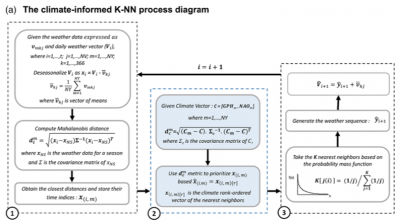Simulating Precipitation in the Northeast United States Using a Climate-Informed K-Nearest Neighbor Algorithm
Decadal prediction using climate models faces long-standing challenges. While global climate models may reproduce long-term shifts in climate due to external forcing, in the near term, they often fail to accurately simulate interannual climate variability, as well as seasonal variability, wet and dry spells, and persistence. Such within-the-year statistics are essential for water resources management. We developed a new climate-informed K-nearest neighbor (K-NN)-based stochastic modeling approach to capture the long-term trend and variability while replicating the within-year statistics. Daily precipitation and temperature are simulated from analog weather days that belong to years similar to the current year's climate state. The climate‐informed K‐NN stochastic model is tested using 53 weather stations in the Northeast United States with an evident monotonic trend in annual precipitation. The model is also compared to ISIMIP‐2b GFDL general circulation model bias‐corrected output in a cross‐validation mode. Results indicate that the climate‐informed K‐NN model provides improved simulations for dry and wet regimes and better uncertainty bounds for annual average precipitation.
Retrospective GCM runs, including re-analysis products, are potentially quite useful in assessing global teleconnections associated with regional hydroclimatology. Applying climate-informed resampling to combine local neighbors with modes of natural climate variability relies on the knowledge of modes of decadal variability of regional climate. Our methodology offers a way to integrate climate information with historical variability for improved simulations. These improved simulations can be used to generate near-term streamflow, which are used for short-term water resources planning and management. Water managers and decision-makers can benefit from this information for robust system design and water resources analysis.
In this study, we develop and present a new climate-informed K-NN algorithm to simulate future weather. The methodology we employ is exploratory, where we examine and incorporate the assumption of non-stationarity with different training and validation periods. We evaluate and compare the skill of the proposed climate-informed resampling scheme with the outputs from the ISIMIP-GFDL model. We look at the model's ability to simulate the 1960s drought and the recent wet climate in the Northeast United States. Results indicate that the climate‐informed K‐NN model provides improved simulations for dry and wet regimes. Hence, we argue that the utilization of historical data and information from climate may reliably replicate secular trends and internal variability in the data for short-term hydrologic planning purposes.

